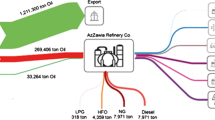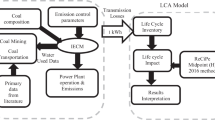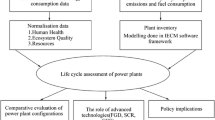Abstract
In this study, a detailed technical-economic analysis on a O2/CO2 recycle combustion power plant (Oxy-combustion plant) retrofitted from the existing coal-fired plant (with a capacity of 2×300 MW) in China was carried out by using life cycle assessment (LCA) and life cycle cost (LCC) method. The CO2 emissions, investment cost, cost of electricity and CO2 avoidance cost within the life cycle were calculated respectively. The results showed that the CO2 emission avoidance rate of retrofitted Oxy-combustion plant in the life cycle was about 77.09% without taking account of the CO2 compression; the annual cost increased by 5.9% approximately, the net power decreased by 21.33%, the cost of electricity increased by 34.77%, and the CO2 avoidance cost was about 28.93 USD/t. Considering the compression process of CO2, the avoidance rate of CO2 emission was about 73.35% or so; the annual cost increased by 9.35% approximately, the net power decreased by about 26.70%, the cost of electricity increased by 49.13%, and the CO2 avoidance cost was about 45.46 USD/t. The carbon tax (the CO2 tax) should be more than about 24 USD/t and 34 USD/t under the condition of considering CO2 compression or not, respectively, which is beneficial to promote transformation of existing coal-fired plant for reducing the CO2 emissions.
Similar content being viewed by others
References
Anderssen K, Johnsson F, Stromberg L. Large scale CO2 capture-applying the concept of O2/CO2 combustion to commercial process data. VGB Powertech, 2003, 83(10): 29–33
Singh D, Croiset E, Douglas P, et al. Techno-economic study of CO2 capture from an existing coal-fired power plant: MEA scrubbing vs. O2/CO2 recycle combustion. Energy Convers Manage, 2003, 44(19): 3073–3091
Xiong J, Zhao H B, Zheng C G, et al. An economic feasibility study of O2/CO2 recycle combustion technology based on existing coal-fired power plants in China. Fuel, 2009, 88(6): 1135–1142
Liu Y, Zhou J H, Fang L, et al. A study on coal combustion and desulfurizaion characteristics in atmosphere containing O2/CO2 (in Chinese). Proc CSEE, 2004, 24(8): 224–228
Nie H J, Li Z, Zhang B. Calculation and analysis of CO2 emission life cycle assessment in integrated gasification combined cycle system (in Chinese). Power Eng, 2004, 24(1): 132–137
Deng N S, Wang X B. Life cycle assessment (in Chinese). Beijing: Chemical Industry Press, 2003
ISO 14040:2006. Environmental management-life cycle assessmentprinciples and frameworks. International Standards Organization, 2006
ISO 14044:2006. Environmental management-life cycle assessment-requirements and guidelines. International Standards Organization, 2006
Luo B L. Application of life cycle cost method in planning and design of combined circulation power plant (in Chinese). Electr Power Constr, 2003, 24(1): 6–9
Niu D X, Wang W J. Evaluation of the life cycle cost of thermal power project based on the goal of sustainable development (in Chinese). Sci Sci Manage S T, 2009, 30(6): 145–148
Liu S N, Lin Z S, Zhang X W. Studies on the life circle assessment of portland cement (in Chinese). China Environ Sci, 1998, 18(4): 328–332
Tahara K, Kojima T, Inaba A. Evaluation of CO2 payback time of power plants by LCA. Energy Convers Manage, 1997, 38(1): S615–S620
Koornneef J, Keulen T, Faaij A, et al. Life cycle assessment of a pulverized coal power plant with post-combustion capture, transport and storage of CO2. Int J Greenh Gas Con, 2008, 2(4): 448–467
Buhre B, Elliott L, Sheng C, et al. Oxy-fuel combustion technology for coal-fired power generation. Prog Energy Combust Sci, 2005, 31(4): 283–307
Zheng Y, Chi B H, Wang B W, et al. CO2 emission control technology for coal combustion (in Chinese). Electric Power, 2006, 39(10): 91–94
Croiset E, Thambimuthu K. NOx and SO2 emissions from O2/CO2 recycle coal combustion. Fuel, 2001, 80(14): 2117–2121
Wang H, Zhang L Z, Lu X H, et al. Microstructure changes of calcium-based sorbent during desulfurizafion in O2/CO2 mixture (in Chinese). J Eng Thermophys, 2001, 22(1): 127–129
Burgess A, Brennan D. Application of life cycle assessment to chemical processes. Chem Eng Sci, 2001, 56(8): 2589–2604
Spath P, Mann M, Kerr D. Life cycle assessment of coal-fired power production. USA: National Renewable Energy Laboratory, 1999. http://www.nrel.gov/docs/fy99osti/25119.pdf5119.pdf
Doctor R, MoIburg J, Brockmeier N, et al. Full fuel cycle study on power generation schemes incorporating the capture and disposal of carbon dioxide. United Kingdom: ETSU, 1994
Nsakala N, Marion J, Bozzuto C, et al. Engineering feasibility of CO2 capture on an existing US coal-fired power plant. In: First National Conference on Carbon Sequestration. Washington: DC, 2001
Yan W P, Mi C L, Liang X J, et al. Calculation and analysis of thermal efficiency for boilers adopting O2/CO2 combustion mode (in Chinese). Therm Power Generation, 2009, 38(6): 20–23
Damen K. Reforming fossil fuels use-the merits, costs and risks of carbon capture and storage. Dissertation of Doctoral Degree. Utrecht: Science, Technology and Society, Utrecht University, 2007
Liao Z R, Fu C L. Product life cycle cost evaluation (in Chinese). Beijing: National Defence Industry Press, 1993
Klemeš J, Bulatov I, Cockerill T. Techno-economic modelling and cost functions of CO2 capture processes. Comput Chem Eng, 2007, 31(5–6): 445–455
Andersson K, Johnsson F. Process evaluation of an 865 MW lignite fired O2/CO2 power plant. Energy Convers Manage, 2006, 47(18–19): 3487–3498
Jiang D H, Yang R Z, Sun Z K. Discussion and study of desulfurization scheme feasibility for utility boilers (in Chinese). Electric Power, 2000, 33(6): 78–81
Wu A F, Li M W, Huang T, et al. Several practical flue gas de-NOx technologies and techno-economic analysis (in Chinese). Electric Power, 2006, 39(11): 71–75
Simbeck D R. CO2 mitigation economics for existing coal-fired power plants. In: First National Conference on Carbon Sequestration. Washington: DC, 2001
IPCC Working Group III Workshop on CO2 Capture and Storage and the CDM. The IPCC special report on carbon dioxide capture and storage. Dakar, Senegal, 2007
Hagem C, Holtsmark B. From small to insignificant: Climate impact of the Kyoto Protocol with and without US. CICERO Policy Note 1, 2001
Jin H G, Zhang X L, Gao L, et al. Fundamental study of CO2 control technologies and policies in China. Sci China Ser E-Tech Sci, 2008, 51(7): 857–870
Author information
Authors and Affiliations
Corresponding author
Rights and permissions
About this article
Cite this article
Wang, Y., Zhao, Y., Zhang, J. et al. Technical-economic evaluation of O2/CO2 recycle combustion power plant based on life-cycle. Sci. China Technol. Sci. 53, 3284–3293 (2010). https://doi.org/10.1007/s11431-010-4164-4
Received:
Accepted:
Published:
Issue Date:
DOI: https://doi.org/10.1007/s11431-010-4164-4




